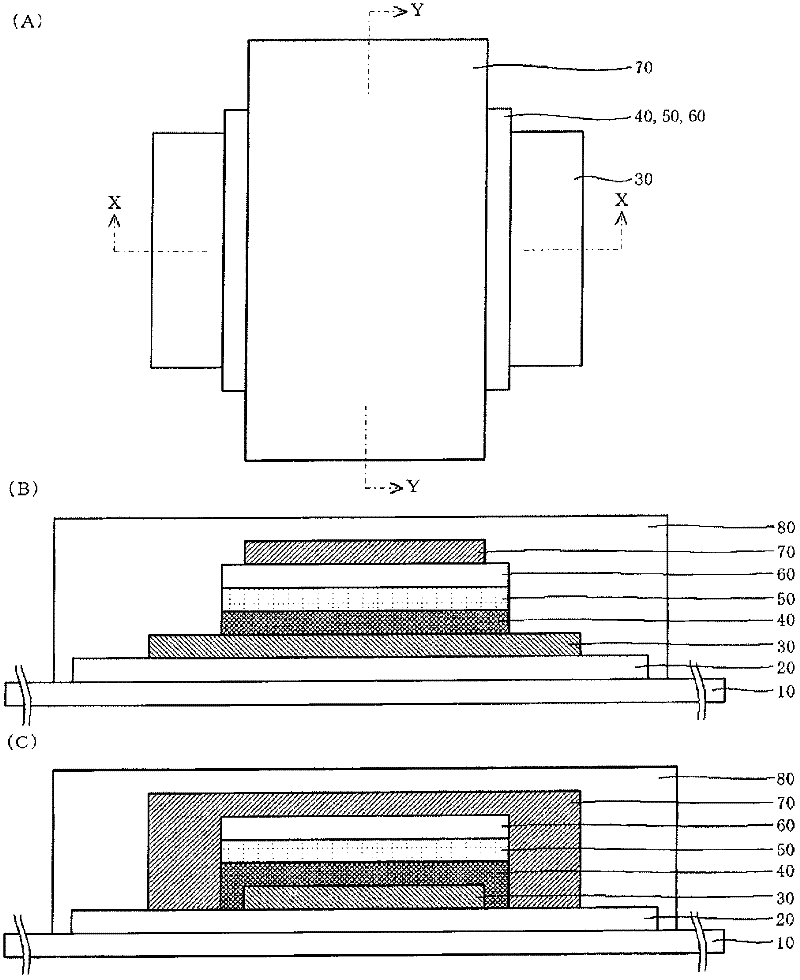Thin film solid lithium ion secondary battery and manufacturing method thereof
A secondary battery and solid-state lithium technology, applied in the field of lithium-ion batteries, can solve problems such as size and thickness limitations, achieve stable yield, stable driving, and improved durability
- Summary
- Abstract
- Description
- Claims
- Application Information
AI Technical Summary
Problems solved by technology
Method used
Image
Examples
Embodiment approach (1
[0055] figure 1 is a view illustrating a schematic structure of a solid-state lithium ion battery in Embodiment (1) of the present invention. figure 1 (A) is a floor plan, figure 1 (B) is a X-X cross-sectional view, figure 1 (C) is a Y-Y cross-sectional view.
[0056] Such as figure 1 As shown, the solid-state lithium ion battery has an inorganic insulating film 20 formed on the face of a substrate (organic insulating substrate) 10 . The solid-state lithium ion battery has a laminate in which a positive electrode-side current collector film 30 , a positive electrode active material film 40 , a solid electrolyte film 50 , a negative electrode active material film 60 , and a negative electrode side current collector film 70 are sequentially formed on an inorganic insulating film 20 body. A total protective film 80 made of, for example, an ultraviolet curing resin is formed to entirely cover the laminated body and the inorganic insulating film 20 .
[0057] figure 1 ...
Embodiment approach (2
[0061] figure 2 is a view illustrating a schematic structure of a solid-state lithium ion battery in Embodiment (2) of the present invention. figure 2 (A) is a floor plan, figure 2 (B) is an X-X cross-sectional view.
[0062] Such as figure 2 As shown, the solid-state lithium ion battery has an inorganic insulating film 20 formed on the face of a substrate (organic insulating substrate) 10 . The solid-state lithium ion battery has a laminated body composed of the positive electrode side current collector film 30 and the positive electrode active material film 40 and a laminated body composed of the negative electrode side current collector film 70 and the negative electrode active material film 60 . The solid electrolyte membrane 50 is formed to entirely cover the above-mentioned two laminates arranged in line on the inorganic insulating film 20, and the overall protective film 80 made of, for example, an ultraviolet curing resin is formed to entirely cover the solid el...
Embodiment 1
[0084] formed with figure 1 The structure shown is a solid-state lithium-ion battery. In consideration of mass production capability and cost, a polycarbonate (PC) substrate having a thickness of 1.1 mm was used as the substrate 10 . Alternatively, a substrate made of a glass material, acrylic, or the like may be used. Any substrate that has no conductivity and whose surface is sufficiently flat with respect to the film thickness of the formed battery can be used. As the inorganic insulating film 20, Si having a thickness of 200 nm 3 N 4 A film is formed on the entire surface of the substrate 10 .
[0085] Such as figure 1 As shown, the laminate is formed by sequentially forming a positive electrode side current collector film 30, a positive electrode active material film 40, a solid electrolyte film 50, a negative electrode active material film 60, and a negative electrode side on an inorganic insulating film 20 using a metal mask. collector film 70 . However, the st...
PUM
| Property | Measurement | Unit |
|---|---|---|
| thickness | aaaaa | aaaaa |
| thickness | aaaaa | aaaaa |
| thickness | aaaaa | aaaaa |
Abstract
Description
Claims
Application Information
 Login to View More
Login to View More - R&D
- Intellectual Property
- Life Sciences
- Materials
- Tech Scout
- Unparalleled Data Quality
- Higher Quality Content
- 60% Fewer Hallucinations
Browse by: Latest US Patents, China's latest patents, Technical Efficacy Thesaurus, Application Domain, Technology Topic, Popular Technical Reports.
© 2025 PatSnap. All rights reserved.Legal|Privacy policy|Modern Slavery Act Transparency Statement|Sitemap|About US| Contact US: help@patsnap.com



